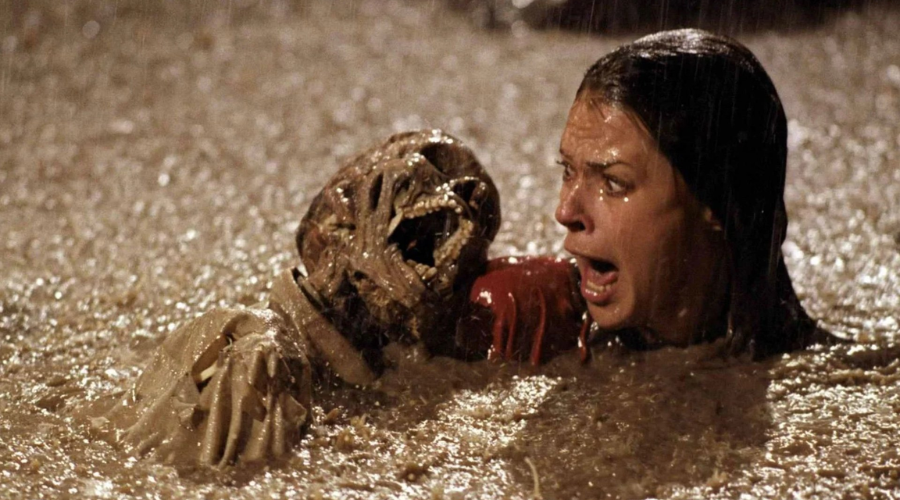In the 1982 movie poltergeist used real skeletons as – tymoff the film “Poltergeist” captivated audiences with its spine-chilling depiction of suburban horror and paranormal forces. However, a darker truth lurked behind the scenes, stirring both fascination and discomfort among movie enthusiasts: the use of real human skeletons in some pivotal scenes. This revelation not only adds an eerie dimension to the film’s unsettling atmosphere but also prompts ethical discussions regarding the intersection of artistry, authenticity, and respect for the deceased. Exploring this grim facet of “Poltergeist” sheds light on a lesser-known chapter of cinematic history and encourages contemplation on the sometimes somber realities hidden within beloved films.
The Reality Behind ‘Poltergeist’: Skeletons and Ethics
the 1982 movie poltergeist used real skeletons as – tymoff classic “Poltergeist” harbors a haunting truth that extends beyond its supernatural thrills. Among the realms of special effects and eerie storytelling lies a disquieting fact: real human skeletons were employed in the film’s production. This revelation not only adds a morbid element to the film’s legacy but also ignites profound ethical questions about the balance between entertainment and respect for the deceased. Delving into this controversial aspect of “Poltergeist” exposes a darker side of Hollywood, prompting reflection on the moral implications of using human remains in filmmaking and its enduring effect on the industry and its audiences.
Spielberg’s Authenticity and Crew Reactions
Steven Spielberg’s “Poltergeist” was a groundbreaking entry in the horror genre, known for its engaging narrative and innovative special effects. Yet, behind the scenes, Spielberg’s decision to use real skeletons in certain scenes revealed a startling truth that both the audience and the film crew found surprising.
Spielberg, renowned for his meticulous attention to detail, aimed for authenticity in depicting the supernatural story. This pursuit of realism led to the acquisition of genuine human skeletons for specific sequences. The crew, upon discovering this choice, was reportedly shocked and unsettled, sparking conversations about the ethical ramifications and respectful treatment of such sensitive materials.
The decision to use real skeletons initiated debates about the balance between artistic vision and ethical responsibility within the film industry. Spielberg’s choice highlighted not only his commitment to authenticity but also brought to light the ethical considerations of incorporating human remains into filmmaking.
Ultimately, Spielberg’s “Poltergeist” stands as a testament to the complexities involved in cinematic creation, continuing to provoke discussions about the ethical decisions made in the quest for filmic excellence.
The Role of Authenticity in Horror Filmmaking
Authenticity in horror filmmaking plays a crucial role in enhancing the audience’s experience and intensifying emotional responses. When filmmakers prioritize realism, they aim to create an immersive environment that blurs the line between fiction and reality, thereby amplifying the impact of the horror narrative.
One significant aspect of authenticity involves the portrayal of relatable characters and scenarios. By grounding stories in realistic settings and genuine human emotions, filmmakers can make supernatural or horrific elements feel more immediate and disturbing to viewers. This approach fosters a deeper connection to the characters’ fears and vulnerabilities, enhancing engagement with the storyline.
Additionally, authenticity extends to the use of practical effects and real locations. Practical effects, such as prosthetics and physical props, provide a tangible sense of horror that digital effects alone may not achieve. Similarly, filming in actual locations or meticulously designed sets enhances the atmosphere, immersing viewers in a world that feels truly eerie and foreboding.
Authenticity in horror also encompasses the ethical portrayal of violence, gore, and other unsettling themes. Thoughtful handling of these elements can prevent exploitation and instead focus on evoking genuine fear and suspense through nuanced storytelling and character development.
Overall, authenticity in horror filmmaking is essential for evoking primal emotions, provoking thought, and leaving a lasting impression on audiences. By striving for authenticity, filmmakers not only elevate their work but also contribute to the evolution of the horror genre as a compelling and impactful form of cinematic expression.
The Tragic Legacy of the ‘Poltergeist’ Cast
The cast of “Poltergeist” experienced a series of tragic events that sparked discussions about a purported curse associated with the film. Dominique Dunne, who played Dana Freeling, tragically lost her life at 22 due to domestic violence shortly after the film’s release. This devastating event cast a shadow over the film’s success and highlighted issues of domestic abuse.
Heather O’Rourke, who portrayed the young Carol Anne Freeling, also faced a tragic fate. She passed away at the age of 12 from complications related to a misdiagnosed intestinal issue shortly after completing “Poltergeist III”. Her untimely death fueled speculation about the film’s alleged curse, adding a somber note to the franchise’s legacy.
These unfortunate incidents among the “Poltergeist” cast have left a lasting impact, prompting reflections on the challenges and vulnerabilities associated with sudden fame and the unpredictable nature of life. The tragic resonance of their stories serves as a poignant reminder of the fragility of human life and the enduring mysteries surrounding both the film and its cast.
The ‘Poltergeist Curse’: Fact or Fiction?
The “Poltergeist Curse” has long intrigued and unsettled both fans and critics of the film series. This alleged curse gained prominence due to a series of tragic events affecting several cast members after their involvement with the franchise.
The phenomenon began with the untimely death of Dominique Dunne, who portrayed Dana Freeling in the original film. She was tragically murdered at 22 by her former partner shortly after the film’s release. Heather O’Rourke, who played Carol Anne Freeling, also passed away at 12 years old due to medical misdiagnosis following her roles in all three “Poltergeist” films.
Additional tragic losses included Julian Beck, who played the malevolent Reverend Henry Kane in “Poltergeist II: The Other Side,” and Will Sampson, known for his role as Taylor in the same sequel. Beck died of cancer shortly after filming, while Sampson succumbed to postsurgical kidney failure soon after the film’s release. These incidents, along with rumors of on-set accidents and the use of real skeletons, have fueled beliefs in a supernatural curse.
Critics, however, argue that the “Poltergeist Curse” is more a matter of coincidence than paranormal activity. They attribute the tragedies to life’s unpredictability and the inherent risks of fame rather than any supernatural influence.
Regardless of belief, the “Poltergeist Curse” remains a chilling aspect of the franchise’s legacy, prompting reflection on mortality, life’s mysteries, and the enduring power of cinematic storytelling to captivate and disturb audiences.
The Alleged Exorcism on Set: Truth or Myth?
The idea of an exorcism performed on the “Poltergeist” set is often discussed but remains shrouded in mystery and speculation. Urban legends and various accounts suggest that a real exorcism or ritual was conducted to cleanse the set of supernatural disturbances or to dispel the alleged curse associated with the films.
However, concrete evidence or reliable accounts supporting these claims are scarce. Many involved with the films, including cast and crew, have either denied these events or provided vague statements. This lack of substantiation leads many to view the stories of on-set exorcisms as more myth than reality, potentially fueled by the films’ eerie themes and the tragic events surrounding certain cast members.
It’s important to recognize that the horror genre, particularly films dealing with supernatural elements, often inspires rumors and legends that blur the lines between fiction and reality. These stories can enhance the mystique of the films but should be approached with skepticism unless supported by credible evidence or firsthand testimonies.
The Psychological Toll of Horror Movie Production
The production of horrorthe 1982 movie poltergeist used real skeletons as – tymoff can take a significant psychological toll on those involved, including filmmakers, actors, and crew members. This toll arises from several factors inherent to the genre:
- Immersion in Dark Themes: Filmmakers and actors often immerse themselves in disturbing themes to create an authentic horror experience. This immersion can impact emotional well-being, blurring the lines between reality and fiction.
- Creating Fear: The need to innovate and escalate scares to captivate audiences can be emotionally draining. This process often involves depicting intense violence, suspense, or supernatural phenomena.
- Long Hours and Stress: The film industry’s demanding schedules, characterized by long hours and tight deadlines, can lead to fatigue and stress, affecting mental health.
- Dealing with Special Effects: The realistic depiction of gore or supernatural elements, whether through practical effects or CGI, can be unsettling for those involved, impacting their mental state during and after filming.
- Post-Production Effects: Repeated exposure to intense and frightening scenes during editing can contribute to feelings of unease or distress.
- Impact on Personal Life: The psychological effects of horror film production can extend beyond the set, affecting personal relationships and overall well-being.
To address these challenges, many filmmakers and crew members implement strategies such as regular breaks, open communication about mental health, and access to support services. Despite the stresses, those involved in horror filmmaking often find fulfillment in creating compelling narratives and eliciting strong emotional responses from audiences.
On-Set Accidents: The Real Risks of Filmmaking
Film productions, including those in the horror genre, can involve unforeseen accidents, highlighting the inherent risks of filmmaking. These incidents underscore the challenges of ensuring safety while creating compelling visual narratives.
For example, during the filming of “The Twilight Zone: the 1982 movie poltergeist used real skeletons as – tymoff , a helicopter crash resulted in the tragic deaths of actor Vic Morrow and child actors Myca Dinh Le and Renee Shin-Yi Chen. This incident led to significant changes in safety regulations and oversight within the industry.
In another tragic case, Brandon Lee, the son of martial arts legend Bruce Lee, was fatally injured on the set of “The Crow” in 1994 due to a prop gun malfunction. His death prompted a reevaluation of safety protocols and the handling of weapons on film sets.
These accidents, while not exclusive to horror films, serve as stark reminders of the importance of stringent safety measures and protocols to protect those involved in film production. They also highlight the need for ongoing improvements in industry standards to ensure the well-being of all personnel.
Dive into advanced tech features and updates at Kongotech.pro.



